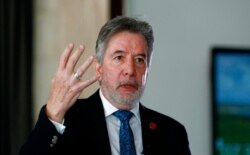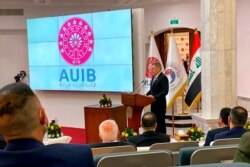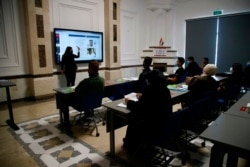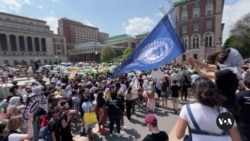Student Union
American University Hopes to Fill Higher-Ed Gap in Iraq
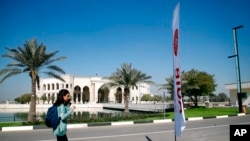
From afar, the sprawling complex of the newly inaugurated American University in Baghdad appears like a floating mirage.
Encircled by blue waters of a human-made lake, former Saddam Hussein-era palaces have been converted to university departments promising a U.S.-style education to meet the needs of Iraq's growing youth.
Higher education has lagged in Iraq since the 2003 U.S.-led invasion that toppled Saddam. Government officials maintain that the American University in Baghdad, which opened this week, is critical to shoring up the country's flailing state of higher education.
The campus is a sight rarely seen in Baghdad's urban sprawl: Ducks float by peacefully, as a handful of students, backpacks slung over their shoulders, head to class. Glossy new buses take others across a winding road.
"I feel more like a mayor of a big city than a university president," AUIB President Michael Mulnix said in an interview with The Associated Press on Monday, a day after the university officially opened its doors.
Critics have raised alarm over the university's funding scheme, which is reliant on one influential Iraqi businessman, while the twin threats of coronavirus and attacks by armed groups threaten to add further delays.
Still, university administrators are forging ahead with plans to expand.
Of the 14 colleges that Mulnix hopes will one day be brimming with avid learners, just three opened this week: Arts and Sciences, Business and International Studies. Five more, including Health Sciences and Law, are planned for the fall.
Also in the works are plans for an international school offering kindergarten through Grade 12, a teaching hospital, even a movie theater. A deal with U.S. fast-food chain Hardee's is close to being inked. Starbucks could be next.
As president, Mulnix's long list of duties befits the ambitious scope of the university, from overseeing mammoth reconstruction efforts of Saddam-era palaces three years ago, to hiring staff, managing food services and paying utility bills.
The university is located on the site where Saddam commissioned the construction of a resort. The project included the grand al-Fao Palace and numerous villas and smaller palaces in the 1990s to mark Iraq's retaking of the al-Fao peninsula during the Iran-Iraq conflict. A lake was formed by diverting water from the Tigris River and filled with a special breed of fish dubbed "Saddam bass."
The initials of the deposed dictator are still etched on the walls, columns and ceilings. Following his capture by U.S forces, he was imprisoned in one of the palace buildings. It was later used as a headquarters of the U.S.-led coalition force and called Camp Victory.
"His presence is here, everywhere," said Mulnix. "It's kind of interesting to take that legacy and transform it into what we are doing."
The dream, he said, was to bring an American-style university with a core liberal arts program to Baghdad. It is not just his vision, but that of the university's chief Iraqi financier, influential businessman Saadi Saihood, whose holdings began with a laundromat in the Green Zone servicing U.S. forces after 2003.
For now, the university is "American" in name only. It will be years before it might be accredited in the United States. They must first produce an initial graduating class, Mulnix said.
So far, the Saihood family has spent $200 million to renovate and refurbish the campus, prompting criticism of too much reliance on the personal wealth of a single businessman.
Mulnix brushed off allegations launched by critics of the university, including some Iraqi and other higher-education officials, that the family was seeking to make money.
"This is 100% a non-for-profit university. All the money made via tuition goes back to the university, not to repay the family that started it."
AUIB is the first American-style university in federal Iraq. Two American-style universities are located in Dohuk and Sulimaniyah in the northern Kurdish-run region.
An American approach to education, which encourages a diverse curriculum, will take time to gain popularity in Baghdad, where high school exam scores determine career paths, and degrees in engineering and medical sciences are favored. Liberal arts is a novel concept in Iraq, Mulnix said.
That might explain why enrollment has not met expectations.
Fewer than 300 students were admitted to AUIB in its inaugural year this year, far short of the 10,000-30,000 its founders hoped for. The majority went directly to the school's English Language Academy to improve their English skills before embarking on a baccalaureate program.
Most of the students have very basic English skills, not enough to meet the rigorous demands of the university, Mulnix said.
"We are having to take over from the very beginning. ... The students coming here really have quite the job because it will take a year or a year and a half for some of them when they are starting at a basic level to get through the English program."
See all News Updates of the Day
- By Tina Trinh
US college students face muted graduations amid Gaza war protests
Commencement ceremonies are being scaled back or canceled at U.S. universities because of security concerns over pro-Palestinian student protests. While some campus demonstrations have resulted in concessions, others have led to violent confrontations. VOA’s Tina Trinh has the story from New York.
- By Melos Ambaye
Police arrest 33 at George Washington University protest encampment

Police in Washington cleared a pro-Palestinian protest encampment at George Washington University early Wednesday, arresting 33 people, authorities said.
Arrests were made on charges of assault on a police officer and unlawful entry, the District of Columbia's Metropolitan Police Department said.
A congressional committee canceled a hearing on the university encampment Wednesday. D.C. Mayor Muriel Bowser and Washington Police Chief Pamela Smith had been scheduled to testify about the city’s handling of the protest before the House Committee on Oversight and Accountability.
University parents and faculty members gathered Wednesday afternoon for a press conference to condemn the handling of the protests by police and school leaders.
“The university clearly does not value the students at all and has endangered the safety of our children by unleashing officers dressed in full riot gear to assault and spray our children in their eyes with pepper spray,” said Hala Amer, whose son participated in the campus protests.
Police said they dispersed demonstrators because "there has been a gradual escalation in the volatility of the protest."
American University professor Barbara Wien said she stayed in the encampment with GW students. She described the student protesters as democratic and peaceful.
Police started to shut down the tent encampment after dozens of protesters marched to GW President Ellen Granberg's on-campus home on Tuesday night. Police were called, but no arrests were made.
Speakers at the conference called for Granberg’s resignation because, they alleged, she refused to meet and negotiate with student protesters.
“You keep inciting violence and ignoring the students,” Amer said about Granberg in an interview with VOA after the conference. “It will just lead to more violence. You need to talk to your students.”
GW officials warned students that they could be suspended for engaging in protests at the school’s University Yard, an outdoor spot on the campus.
"While the university is committed to protecting students' rights to free expression, the encampment had evolved into an unlawful activity, with participants in direct violation of multiple university policies and city regulations," a GW statement said.
More than 2,600 people have been arrested at universities across the country in pro-Palestinian protests, according to The Associated Press.
Students are calling on their university administrations to divest investments from Israel or companies with ties to Israel. Demonstrators have gathered in at least 50 campuses since April 17, carrying signs that read "Free Palestine" and "Hands off Rafah."
Rafah is Gaza’s southernmost city, where most of the territory’s population has clustered. The area is also a corridor for bringing humanitarian aid into the Palestinian territory.
Israel seized the Gaza side of the Rafah crossing on Tuesday, while shutting off the nearby Kerem Shalom crossing, drawing criticism from humanitarian groups. Israel said Wednesday that it had reopened Kerem Shalom.
The nationwide campus protests started in response to Israel's offensive in Gaza that began after Hamas launched a terror attack on Israel on October 7, killing about 1,200 people and taking roughly 250 hostages.
More than 34,000 Palestinians have been killed in Israel's offensive, according to the Gaza Health Ministry. Israel warned it could "deepen" its operation in Rafah if talks failed to secure the release of the hostages.
Some information for this report came from The Associated Press.
- By VOA News
What to ask on a college visit
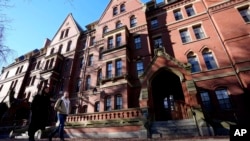
Sarah Wood lists 32 questions for applicants to learn more during a campus visit. (April 2024)
- By VOA News
US is now the most desirable country for international students
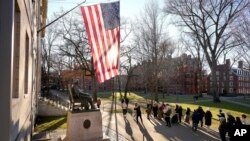
That’s according to this year’s Emerging Futures research survey, from education consultant IDP Connect. Other Western countries have slipped due to new visa restrictions and caps on international students. Read a summary of the research from ICEF Monitor. (April 30, 2024)
Pro-Palestinian protesters break through barricades to retake MIT encampment

Pro-Palestinian protesters who had been blocked by police from accessing an encampment at the Massachusetts Institute of Technology on Monday broke through fencing, linked arms and encircled tents that remained there, as Columbia University canceled its university-wide commencement ceremony following weeks of pro-Palestinian protests.
Sam Ihns, a graduate student at MIT studying mechanical engineering and a member of MIT Jews for a Ceasefire, said the group has been at the encampment for the past two weeks and that they were calling for an end to the killing of thousands of people in Gaza.
"Specifically, our encampment is protesting MIT's direct research ties to the Israeli Ministry of Defense," he said.
Protesters also sat in the middle of Massachusetts Avenue, blocking the street during rush hour in the Boston area.
The demonstrations at Columbia have roiled its campus and officials said Monday that while it won't hold it's main ceremony, students will be able to celebrate at a series of smaller, school-based ceremonies this week and next.
The decision comes as universities around the country wrangle with how to handle commencements for students whose high school graduations were derailed by COVID-19 in 2020. Another campus shaken by protests, Emory University, announced Monday that it would move its commencement from its Atlanta campus to a suburban arena. Others, including the University of Michigan, Indiana University and Northeastern, have pulled off ceremonies with few disruptions.
Columbia's decision to cancel its main ceremonies scheduled for May 15 saves its president, Minouche Shafik, from having to deliver a commencement address in the same part of campus where police dismantled a protest encampment last week. The Ivy League school in upper Manhattan said it made the decision after discussions with students.
"Our students emphasized that these smaller-scale, school-based celebrations are most meaningful to them and their families," officials said.
Most of the ceremonies that had been scheduled for the south lawn of the main campus, where encampments were taken down last week, will take place about 8 kilometers (5 miles) north at Columbia's sports complex, officials said.
Speakers at some of Columbia's still-scheduled graduation ceremonies include Pulitzer Prize-winning playwright James Ijames and Dr. Monica Bertagnolli, director of the National Institutes of Health.
Columbia had already canceled in-person classes. More than 200 pro-Palestinian demonstrators who had camped out on Columbia's green or occupied an academic building were arrested in recent weeks.
Similar encampments sprouted up elsewhere as universities struggled with where to draw the line between allowing free expression while maintaining safe and inclusive campuses.
The University of Southern California earlier canceled its main graduation ceremony. Students abandoned their camp at USC on Sunday after being surrounded by police and threatened with arrest.
Other universities have held graduation ceremonies with beefed-up security. The University of Michigan's ceremony was interrupted by chanting a few times Saturday. In Boston on Sunday, some students waved small Palestinian or Israeli flags at Northeastern University's commencement in Fenway Park.
Emory's ceremonies scheduled for May 13 will be held at the GasSouth Arena and Convocation Center in Duluth, almost 20 miles (30 kilometers) northeast of the university's Atlanta campus, President Gregory Fenves said in an open letter.
"Please know that this decision was not taken lightly," Fenves wrote. "It was made in close consultation with the Emory Police Department, security advisors and other agencies — each of which advised against holding commencement events on our campuses."
The 16,000-student university is one of many that has seen repeated protests stemming from the conflict that started Oct. 7 when Hamas militants attacked southern Israel, killing about 1,200 people, mostly civilians, and taking roughly 250 hostages. Student protesters are calling on their schools to divest from companies that do business with Israel or otherwise contribute to the war effort.
Vowing to destroy Hamas, Israel launched an offensive in Gaza that has killed more than 34,500 Palestinians, about two-thirds of them women and children, according to the Health Ministry in the Hamas-ruled territory. Israeli strikes have devastated the enclave and displaced most of its inhabitants.
Hamas on Monday announced its acceptance of an Egyptian-Qatari cease-fire proposal, but Israel said the deal did not meet its "core demands" and that it was pushing ahead with an assault on the southern Gaza town of Rafah.
"Cease-fires are temporary," said Selina Al-Shihabi, a Georgetown University sophomore who was taking part in a protest at George Washington. "There can be a cease-fire, but the U.S. government will continue to arm the Israeli military. We plan to be here until the university divests or until they drag us out of here."
At the University of California, San Diego, police cleared an encampment and arrested more than 64 people, including 40 students.
The University of California, Los Angeles, moved all classes online for the entire week due to ongoing disruptions following the dismantling of an encampment last week. The university police force reported 44 arrests but there were no specific details, UCLA spokesperson Eddie North-Hager said in an email to The Associated Press.
Schools are trying various tactics from appeasement to threats of disciplinary action to get protestors to take down encampments or move to campus areas where demonstrations would be less intrusive.
The School of the Art Institute of Chicago said in a Facebook post Sunday that it offered protesters "amnesty from academic sanction and trespassing charges" if they moved.
"Many protesters left the premises of their own accord after being notified by the police that they were trespassing and subject to arrest," the school said. "Those that remained were arrested after multiple warnings to leave, including some of whom we recognized as SAIC students."
A group of faculty and staff members at University of North Carolina at Chapel Hill asked the administration for amnesty for any students who were arrested and suspended during recent protests. UNC Faculty and Staff for Justice in Palestine said in a media advisory that it would deliver a letter on behalf of more than 500 faculty who support the student activists.
Other universities took a different approach.
Harvard University's interim president, Alan Garber, warned students that those participating in a pro-Palestinian encampment in Harvard Yard could face "involuntary leave." That means they would not be allowed on campus, could lose their student housing and may not be able to take exams, Garber said.




